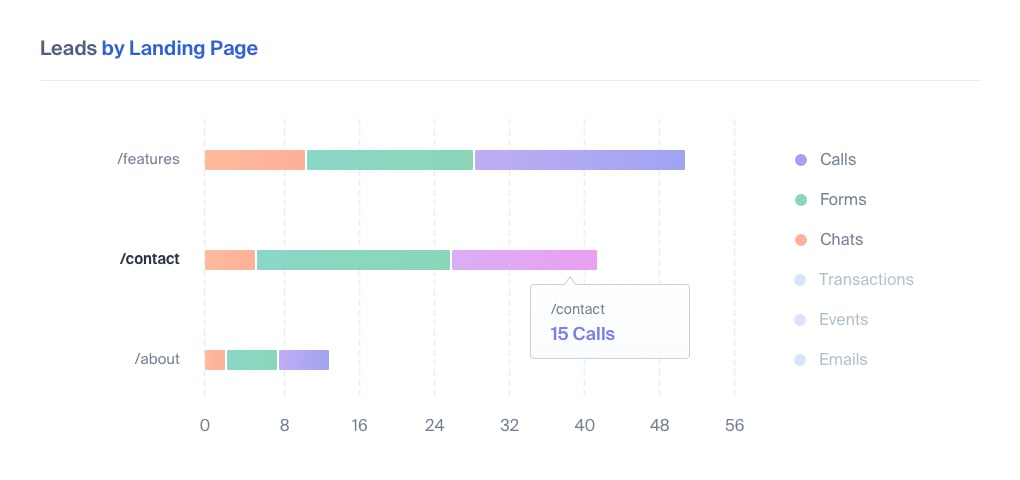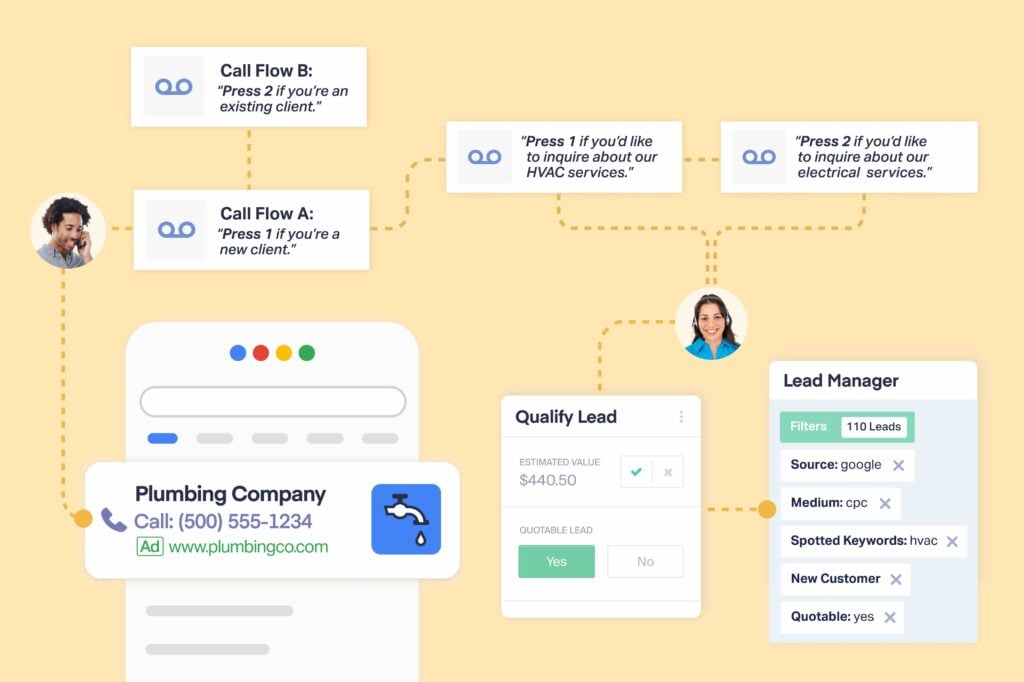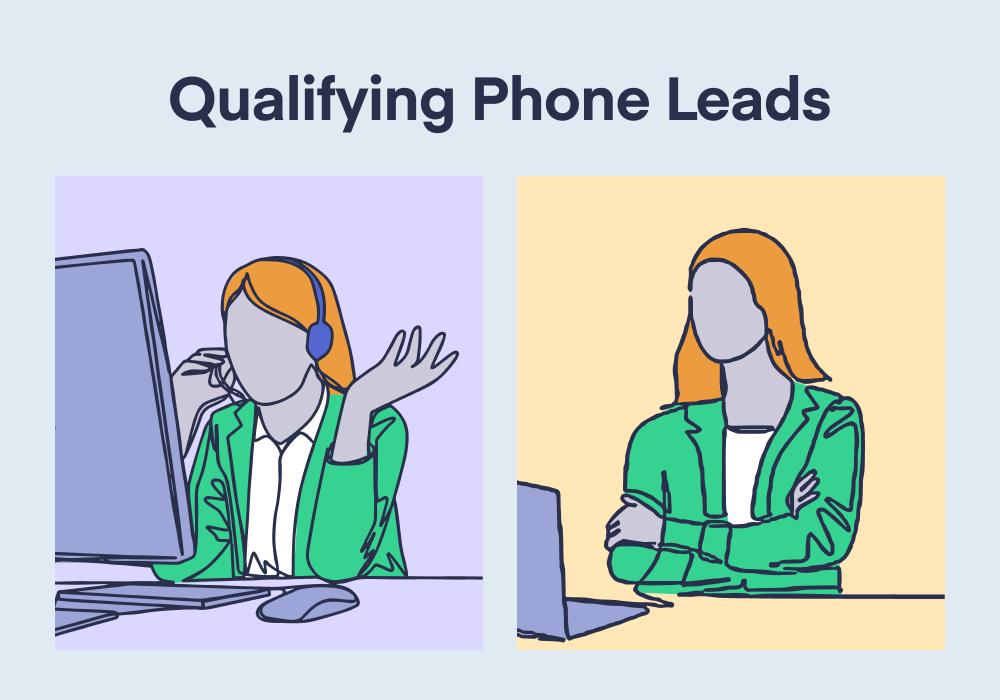
If you could only get one type of lead (phone call, form fill, email, chat message), what would you choose? If you didn’t say phone call, shame on you. Calls are 10-15 times more likely to convert than other lead types. And that’s why it’s so important to know how to qualify a lead over the phone.
To be clear, not all businesses will have the same qualification process. And that’s a good thing—not all businesses should. But there are a few across-the-board things you should know about how to qualify a lead if they call you or your client. And that’s what this article looks at.
We’ll talk about why you should be qualifying phone call leads, two main methods for doing so (along with breaking down techniques for different business types), and tips for automating your lead qualification so you and your team can be more productive than ever.
Why Qualifying Phone Call Leads Is Crucial
Phone call leads are often high-intent. They’re more likely to convert, meaning you don’t have to spend as much time and resources turning them into customers. But even still, lack of a proper qualification procedure risks wasting those resources on unfit prospects or missing revenue opportunities. Effective lead qualification ensures sales teams focus on the right leads, improving conversion rates and maximizing ROI.
1. Maximizing Sales Efficiency
Sales teams have limited time and resources. By qualifying leads early, businesses can prioritize high-value prospects and avoid spending time on unqualified or low-intent callers. Structured qualification—whether through live assessments or post-call analysis—helps filter out leads that lack budget, authority, or urgency.
2. Leveraging Data for Smarter Decision-Making
Post-call qualification tools, such as AI-powered call summaries and lead scoring, provide valuable insights into customer intent and buying signals. For example, businesses using WhatConverts can analyze call data to refine their marketing and sales strategies, focusing on lead sources that drive the best results.
3. Improving Lead Quality & Conversion Rates
Not all inbound calls translate into sales. Some may be accidental dials, irrelevant inquiries, or unqualified prospects. In fact, some leads will even click ads and call a business looking for a job (our lawncare agency customers see it all the time). Implementing a structured qualification process ensures that sales teams engage only with leads most likely to convert, leading to better close rates and higher revenue.
By integrating lead qualification into their workflow, businesses can optimize resources, improve sales performance, and ensure every call contributes to revenue growth.
Now that we better understand the “why” here, let’s look at the two main methods for how to qualify a lead over the phone:
- While on the call
- After the call
Method 1: Qualifying Leads While on the Line
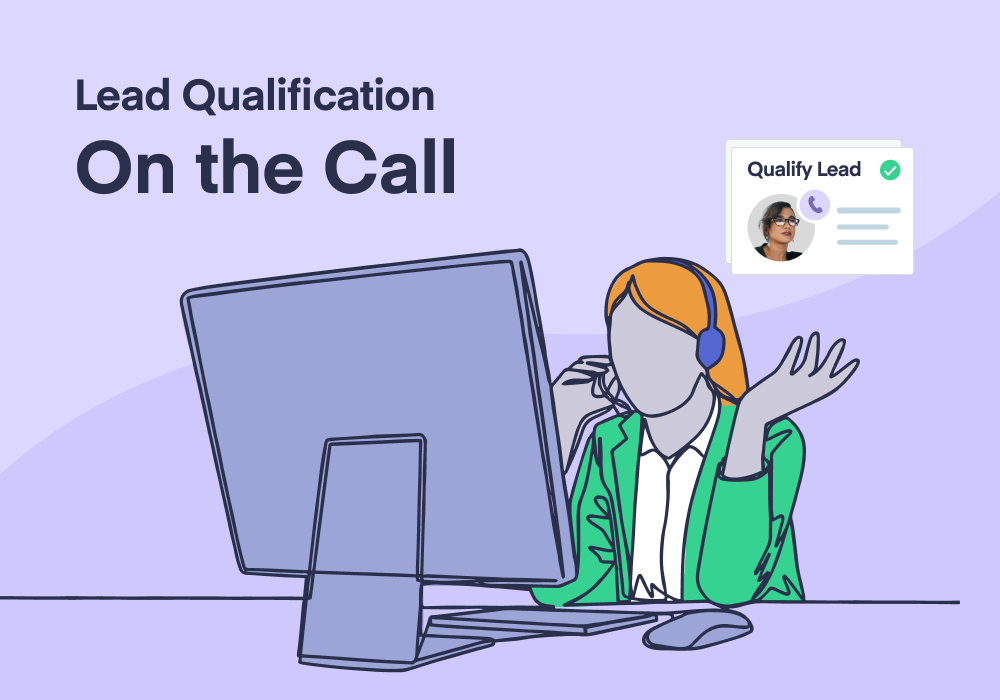
Alternatively, you can use tools to automate lead qualification. For example, WhatConverts’ Call Flows lets leads qualify themselves on the line, ensuring that only high-quality leads move forward while filtering out unqualified prospects in real-time.
Let’s take a closer look at all three approaches.
Short-Cycle Leads: Ask Straightforward Qualification Questions
If you're a business with a short sales cycle—such as home services, dental practices, or local repair companies—your goal is to qualify leads quickly and move them toward booking an appointment or making a purchase. Since these leads are typically ready to buy, your qualification process should focus on three key questions:
| Qualification Question | Why It Matters | Example Question |
| Is the lead in your service area? | Avoids wasting time on callers outside your geographic reach. | "Can I confirm your location? We currently serve [area]." |
| Does the lead have an immediate need? | Prioritizes urgent leads for higher conversions. | "Are you looking for [service] today, or planning ahead?" |
| Does the lead meet your basic criteria? | Determines if they are a new or returning customer and if their needs align with your services. | "Have you used our service before?" or "What issue are you facing?" |
By ensuring your qualification framework hits all three of these points, you should have all the information you need to know if this lead is likely to become an ideal customer.
Tips for Qualifying Short-Cycle Phone Call Leads
- Keep Questions Clear and Direct: Short-cycle leads don’t have time for long, drawn-out conversations. Ask straightforward questions that immediately determine fit.
- Example: “Are you looking to book an appointment today?”
- Leverage Call Routing to Prioritize Urgent Leads: Use automated call routing to connect high-intent leads with a rep immediately, while lower-priority leads can be sent to voicemail or a nurture sequence (see Call Flows below).
- Qualify & Book in the Same Call: For short sales cycles, getting a commitment during the first call is crucial. Once a lead is qualified, move straight into scheduling or closing the deal.
- Example: “Great! We have an opening this afternoon or tomorrow morning—which works better?”
Long-Cycle Leads: Use Sales Frameworks for Real-Time Lead Qualification
For industries that have a longer sales cycle (B2B software, real estate, financial services), using structured qualification frameworks helps uncover key information quickly. Below is a comparison of popular lead qualification frameworks and example questions for each:
| Framework | Focus | Example Questions |
| BANT (Budget, Authority, Need, Timeline) | Determines if the lead has the financial resources, decision-making power, a clear need, and a purchase timeline. | - What budget have you allocated for this? - Who is involved in the purchasing decision? - What specific challenge are you trying to solve? - When do you plan to implement a solution? |
| CHAMP (Challenges, Authority, Money, Prioritization) | Focuses on identifying pain points and ensuring the lead is motivated to take action. | - What is your biggest challenge right now? - Are you the one making the final decision? - Do you have the budget to address this issue? - How important is solving this problem to your business? |
| GPCT (Goals, Plans, Challenges, Timeline) | Evaluates long-term business objectives and how they align with the solution. | - What goals are you trying to achieve? - What plans have you already put in place? - What roadblocks are preventing progress? - When do you need a solution implemented? |
| MEDDIC (Metrics, Economic Buyer, Decision Criteria, Decision Process, Identify Pain, Champion) | Focuses on measurable business impact and navigating internal decision-making. | - What specific metrics will define success? - Who has the final say in purchasing? - What criteria are you using to evaluate solutions? - What’s your internal decision-making process? - What pain points are driving the need for this solution? - Do you have an internal advocate for this purchase? |
Common Mistakes When Using Sales Qualification Frameworks
Sales qualification frameworks help teams identify high-quality leads, but misusing them can lead to lost opportunities. Here are three critical mistakes to avoid:
1. Treating the Framework as a Script
Many sales reps follow qualification frameworks rigidly, turning conversations into interrogations. Instead of mechanically asking each question, reps should adapt their approach based on the lead’s responses, making the conversation feel natural and engaging.
2. Overemphasizing Budget Too Early
Bringing up budget too soon can deter potential leads who may not have a set number in mind but are willing to invest in the right solution. Instead of leading with, “What’s your budget?” focus on their challenges and goals before discussing pricing.
3. Ignoring Post-Call Insights
Relying solely on real-time qualification can be limiting. Post-call data, such as call recordings and AI-powered summaries, can reveal deeper intent signals that weren’t obvious during the conversation, helping teams prioritize follow-ups effectively.
Avoiding these mistakes ensures a smoother qualification process, improving both conversion rates and lead quality.
Using Call Flows for Automated Qualification
Call Flows lets callers self-qualify by selecting different options on a call path, essentially automating lead qualification in real-time. Businesses can set up a structured call-routing system that asks pre-set qualification questions, directing leads based on their responses. This ensures that sales reps only engage with high-quality leads while reducing time spent on unqualified callers.
For example, a home services company can use Call Flows to ask, “Are you looking for service within the next 30 days?” before connecting the caller to a representative. If the answer is “No,” the lead can be automatically redirected to an informational voicemail or nurture sequence.
For example, a plumbing company can set up a Call Flow to ask:
- “Are you dealing with an emergency?”
- If Yes, the caller is routed to a priority line.
- If No, they may be offered scheduling options.
With Call Flows, you don’t have to eat up your team’s time by asking these qualification questions. On top of that, the right call-tracking software will automatically track your Call Flow data and organize your leads based on their responses.
What You Can Do With Call Flows in WhatConverts
- Qualify or Disqualify a Lead – If a caller fails a spam check, they can automatically be disqualified. Similarly, if a caller wants to schedule an appointment in your area, they can be marked qualified.
- Add a Service Type to a Lead – Based on the service they select on the call, you can add that service type to their lead data. This data will help you see which marketing channels are generating which service types.
- Add a Value to a Lead – Based on the service type they select, you can also add a value to that lead based on the service. For example, a yearly maintenance lead may be worth $250, while an HVAC installation would be worth $10,000.
Method 2: Qualifying Leads After the Call
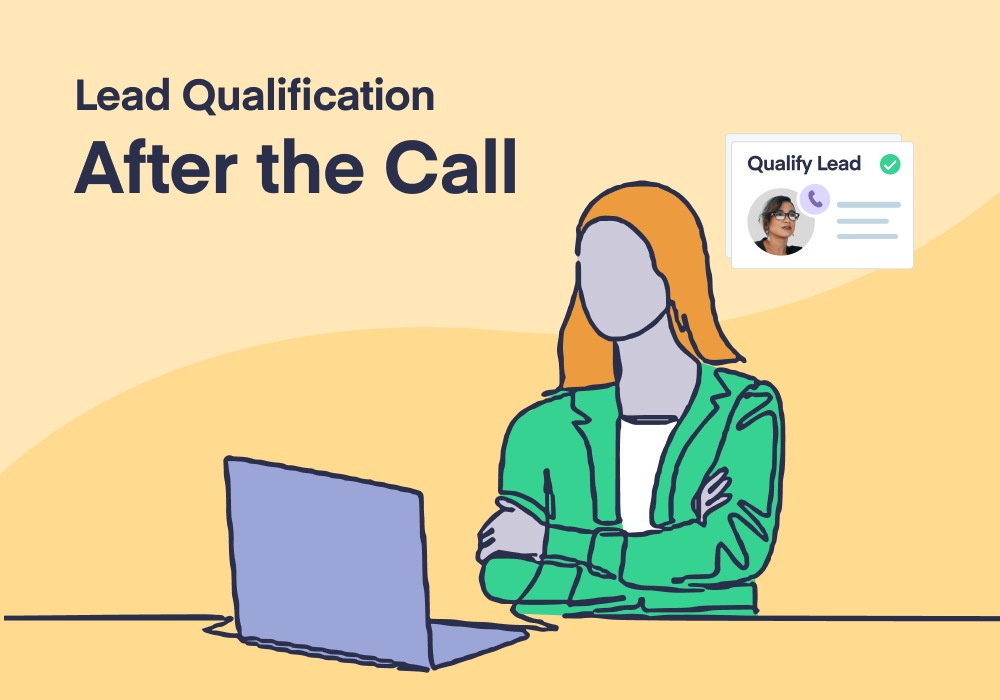
Implementing Post-Call Qualification Flows
Once a call ends, sales teams should follow a structured qualification process to finalize whether a lead is worth pursuing. WhatConverts allows businesses to create custom post-call workflows that:
- Assign a lead score based on call duration, engagement level, and intent.
- Trigger automated follow-ups, such as sending the lead a pricing guide or scheduling a demo.
- Categorize leads into different sales pipelines for targeted nurturing.
For instance, if a lead mentions that they are interested but need approval from their boss, the sales rep can flag the lead for a scheduled follow-up in a week. If the caller was vague or unsure, they might be placed in a lower-priority nurture campaign.
Beyond that, you can even add post-call qualification prompts to your Call Flows so that reps can add this information on the line right after the lead hangs up. It’s a great way to ensure your sales team is following the workflow and qualifying consistently.
Using Lead Source & Intent Data
One of the best ways to assess lead quality after a call is to analyze where the lead came from. WhatConverts automatically tracks lead sources, revealing whether the caller found the business through high-intent sources like Google Ads or lower-intent channels like social media. If a lead originated from a PPC campaign targeting high-buying-intent keywords, they are more likely to be sales-ready.
In WhatConverts, you can easily see this attribution data from the Lead Manager… 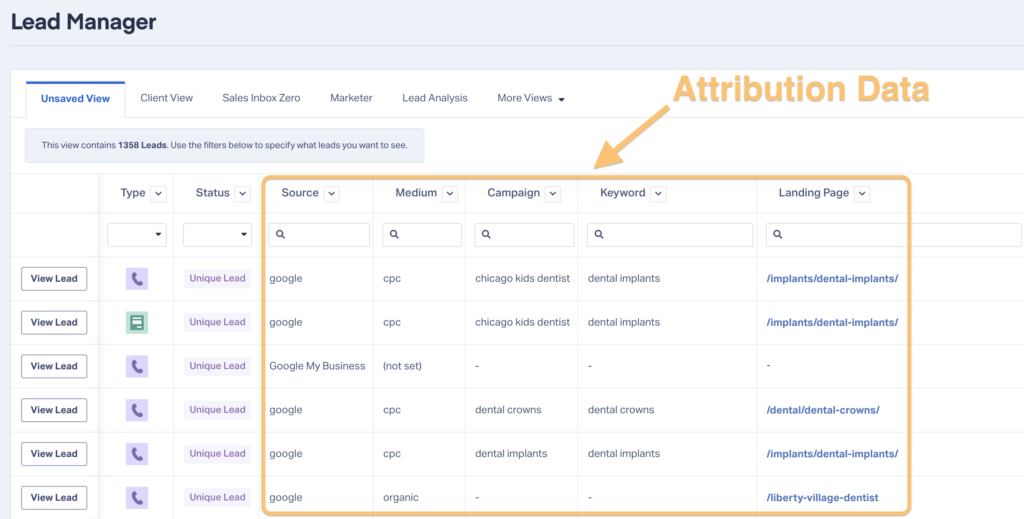
Or the Lead Details page… 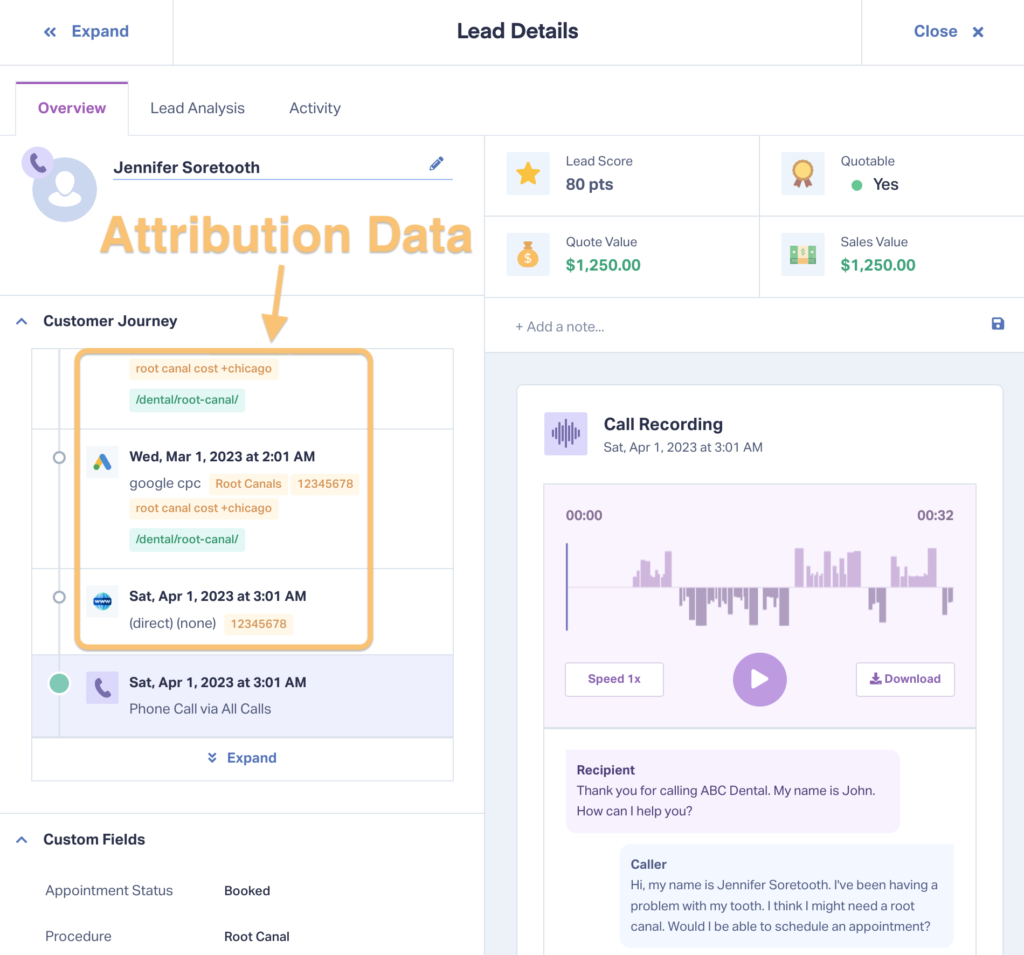
Evaluating Lead Quality with Call Recording & Transcription
WhatConverts’ Call Recording and Transcription features allow sales teams to review calls for key insights. If a call was too short or lacked clear purchase signals, the lead may not be worth prioritizing. On the other hand, if a lead asked detailed pricing questions or expressed clear intent, they should be flagged for follow-up. 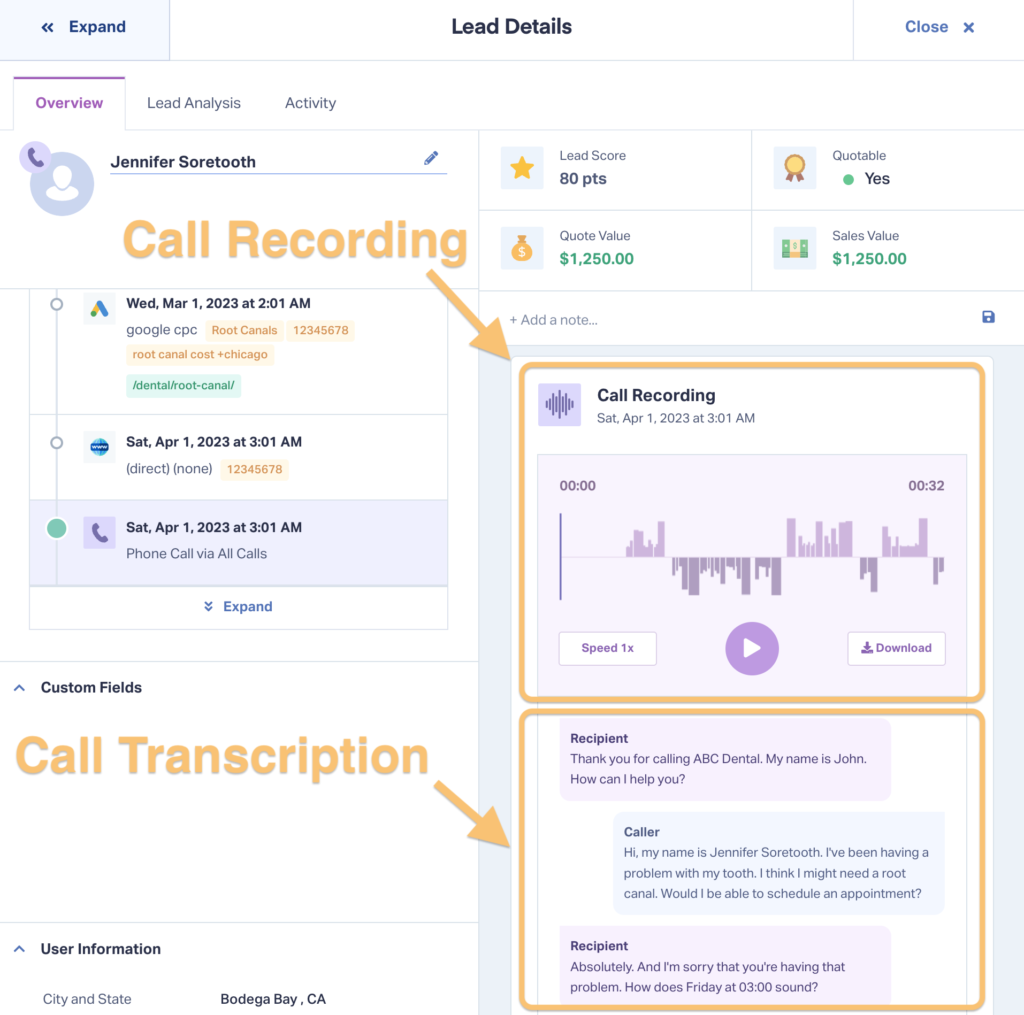
AI-Powered Call Summary & Lead Analysis
AI-driven tools like Call Summary and Lead Analysis in WhatConverts automatically extract key details from calls, eliminating the need for manual review. AI can:
- Identify high-intent keywords used during the call.
- Provide a summary of the conversation, highlighting key points.
- Score leads based on conversational indicators using Lead Intelligence, helping sales teams quickly prioritize the most promising opportunities.
Frequently Asked Questions (FAQs) on Lead Qualification
When should a lead be qualified?
Leads should be qualified as early as possible in the sales process. Ideally, this happens during the initial phone call using structured questions and frameworks. However, post-call qualification through call recordings, AI analysis, and lead scoring also play a crucial role in refining lead quality.
What are the key questions to ask when qualifying a lead?
Some essential qualification questions include:
- “What problem are you trying to solve?” to assess need.
- “What’s your budget for this?” to evaluate financial fit.
- “Are you the decision-maker, or is there someone else involved?” to confirm authority.
- “When are you looking to move forward?” to gauge urgency.
How can automation help in lead qualification?
Automation tools like WhatConverts’ Call Flows, Call Summary, and Lead Analysis help businesses qualify leads efficiently. These tools track call data, assign lead scores, and trigger automated follow-ups, allowing sales teams to focus on high-value leads.
What are common signs of an unqualified lead?
Unqualified leads often exhibit vague inquiries, lack urgency, have no clear budget, or lack decision-making authority. Identifying these traits early helps sales teams avoid spending time on leads that are unlikely to convert.
Wrapping Up
Qualifying phone call leads requires a two-pronged approach: real-time assessment while on the line and post-call evaluation using data and automation. By implementing structured sales frameworks and leveraging WhatConverts’ tools like Call Flow, Call Summary, and Lead Analysis, businesses can maximize lead quality and improve sales efficiency.
Want to automate your lead qualification process? Try 14 days of WhatConverts for free today!
Get a FREE presentation of WhatConverts
One of our marketing experts will give you a full presentation of how WhatConverts can help you grow your business.
Schedule a Demo
Grow your business with WhatConverts






